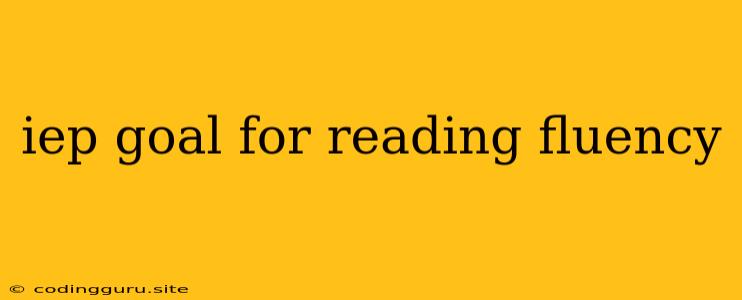IEP Goals for Reading Fluency: A Guide for Educators and Parents
Developing reading fluency is a crucial part of a student's educational journey. It empowers them to access and comprehend information, engage in meaningful conversations, and succeed in their academic endeavors. For students with Individualized Education Programs (IEPs), achieving reading fluency may require specialized support and tailored goals.
This guide will delve into the intricacies of crafting effective IEP goals for reading fluency, addressing essential considerations for educators and parents alike.
Understanding Reading Fluency: The Foundation for Comprehension
Before diving into goal-setting, it's essential to understand what reading fluency entails. It goes beyond simply decoding words; it encompasses:
- Accuracy: The ability to read words correctly.
- Rate: The speed at which a student reads.
- Prosody: The expression and intonation used while reading, reflecting an understanding of the text's meaning.
Students who struggle with reading fluency often exhibit one or more of the following:
- Slow reading pace: They may read word by word, pausing frequently, or stumbling over unfamiliar words.
- Poor comprehension: Even if they decode words accurately, they may struggle to understand the text's meaning due to a lack of fluency.
- Lack of engagement: They may appear disengaged during reading activities, showing little interest in the material.
Crafting Effective IEP Goals for Reading Fluency: A Step-by-Step Approach
1. Assessment is Key:
Begin by conducting a thorough assessment of the student's current reading fluency level. This might involve:
- Formal assessments: Utilize standardized tests like the Dynamic Indicators of Basic Early Literacy Skills (DIBELS) or the Oral Reading Fluency (ORF) test.
- Informal assessments: Observe the student's reading during classroom activities, record their reading rate and accuracy, and analyze their reading strategies.
2. Set Specific, Measurable, Achievable, Relevant, and Time-Bound (SMART) Goals:
Specific: Clearly define what the student will achieve. Measurable: How will progress be measured? Achievable: Set realistic goals that the student can achieve within a reasonable timeframe. Relevant: Align the goal with the student's individual needs and overall IEP objectives. Time-Bound: Establish a clear deadline for reaching the goal.
Example:
- Specific: Increase the student's reading rate from 50 words per minute to 70 words per minute.
- Measurable: Measure reading rate using a standardized test like ORF.
- Achievable: This is a realistic goal to achieve within a semester.
- Relevant: Improving reading rate is essential for comprehension and engagement.
- Time-Bound: The student will achieve this goal within the next 6 months.
3. Tailor the Goal to the Student's Needs:
- Focus on one aspect of fluency at a time: For example, if the student's primary issue is accuracy, focus on that aspect before addressing rate or prosody.
- Consider the student's interests and learning style: Use motivating materials and activities that align with their interests and learning preferences.
- Provide scaffolding and support: Break down complex tasks into smaller steps, offer visual aids, and provide explicit instruction on reading strategies.
4. Regular Monitoring and Evaluation:
Monitor the student's progress regularly using the chosen assessment tools. Adjust the goals and interventions as needed to ensure the student continues to make progress.
5. Collaborate with Parents and Teachers:
Open communication between parents, teachers, and specialists is vital for successful IEP goal implementation. Share progress reports, discuss strategies, and brainstorm ways to reinforce learning at home.
6. Examples of IEP Goals for Reading Fluency:
Here are some examples of IEP goals that address different aspects of reading fluency:
- Accuracy:
- The student will be able to read a 100-word passage with 95% accuracy.
- The student will improve their accuracy in reading high-frequency words by 20% within the next quarter.
- Rate:
- The student will read at a rate of 80 words per minute with 90% accuracy on a second-grade reading passage.
- The student will increase their reading speed by 10 words per minute on age-appropriate passages within 3 months.
- Prosody:
- The student will read with appropriate expression and intonation, using pauses and emphasis to convey meaning, on 8 out of 10 passages.
- The student will demonstrate proper phrasing and intonation while reading, demonstrating an understanding of punctuation and sentence structure, on 75% of read-aloud passages.
7. Beyond Fluency: Connecting the Dots to Comprehension:
While reading fluency is crucial, it's not the sole determinant of comprehension. Encourage students to:
- Engage in active reading: Use strategies like asking questions, making predictions, and summarizing to deepen understanding.
- Connect reading to real-life experiences: Discuss how the text relates to their own lives or current events.
- Practice reading across different genres: Expose students to various types of texts to broaden their reading repertoire and comprehension skills.
Tips for Parents: Supporting Reading Fluency at Home
- Make reading fun and engaging: Choose books that align with the student's interests and reading level.
- Read aloud together: Model fluent reading and encourage the student to read along.
- Provide opportunities for repeated readings: This helps build confidence and fluency.
- Use technology to enhance reading practice: Interactive games, online reading programs, and audiobooks can make reading more enjoyable.
- Stay positive and encourage effort: Praise the student's progress and celebrate their achievements.
Conclusion
Crafting effective IEP goals for reading fluency is a collaborative process involving parents, educators, and specialists. By utilizing assessment, setting SMART goals, providing tailored support, and monitoring progress, we can empower students to become confident and fluent readers, unlocking the doors to a world of knowledge and opportunity.
